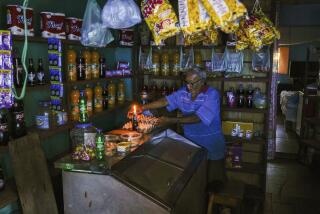Strikers Keep Up Pressure in Nicaragua : Labor strife: The army and police are attempting to keep order. But the question remains whether they will back the Chamorro government.
- Share via
MANAGUA, Nicaragua — Backers and opponents of a Sandinista-led strike clashed across the Nicaraguan capital Tuesday, turning the city into a chaotic mix of roadblocks and gunfire. The strikers showed no sign of easing their heaviest pressure yet on the U.S.-backed government.
Late Monday night, President Violeta Barrios de Chamorro called out the army and police to restore order. Both are controlled by the Sandinistas.
Police and army troops pulled down roadblocks and cleaned up after street bonfires Tuesday but did not oust strikers from the government ministries and state-owned businesses they occupy.
Strike backers built even more roadblocks to replace those taken down.
Whether the army and police ultimately will back Chamorro’s new government or let the strike widen is considered a crucial issue in the outcome of the series of walkouts, now in their second week.
“We mustn’t repress the people,” one police officer said.
The Sandinista-led unions called the strike to protest what they said were massive firings of government workers and to demand a voice in economic policy, which they say favors the wealthy.
Labor leaders say 90,000 people are taking part in the strike. Chamorro’s government declared the action illegal last week, charging that it is politically motivated.
Gunfire spread from the working-class neighborhoods of eastern Managua to the central section at the offices of the pro-government radio station Radio Corporation, where armed pro-government civilians are holed up.
The civilians said they are protecting the station from Sandinistas who want to burn it.
At least three people have been reported killed and about 100 wounded since the strike turned violent Monday.
Many of the pro-Sandinista groups at the roadblocks are armed with AK-47 assault rifles, standard issue in the Sandinista army.
Thousands of the rifles were distributed to Sandinista sympathizers after the Sandinistas lost the presidential election to Chamorro on Feb. 25, ending 10 years of revolutionary rule. Government demands that the weapons be returned have been largely ignored.
The Sandinistas remain the largest single political force in the country. Chamorro won the elections with the backing of a 14-party coalition that ranged from the far right to the Communists and had in common little more than a distaste for the Sandinistas.
Most government ministries and many state-run enterprises have been taken over by strikers. The international airport is closed by an air traffic controllers’ strike, and water has been cut to some parts of the city.
Electrical service was restored Tuesday, but workers said they would start selective cuts around the capital.
Postal workers are on strike. So are telephone operators, leaving the relatively few Nicaraguans with direct-dial capacity the only ones who can communicate outside the country.
Telephone workers threatened Monday to cut service entirely, but non-operator-assisted calls were going through Tuesday.
Driving was difficult in some areas, impossible in others, because of the barricades made from paving stones and other materials.
Former President Daniel Ortega, who was seen cruising the streets of the capital hours before the first barricades went up, said that any effort to end the strike by force would invite “generalized chaos.”
He demanded a resumption of negotiations, suspended by the government over the weekend because it said the union leaders wanted to discuss political, not economic, issues.
More to Read
Sign up for Essential California
The most important California stories and recommendations in your inbox every morning.
You may occasionally receive promotional content from the Los Angeles Times.










